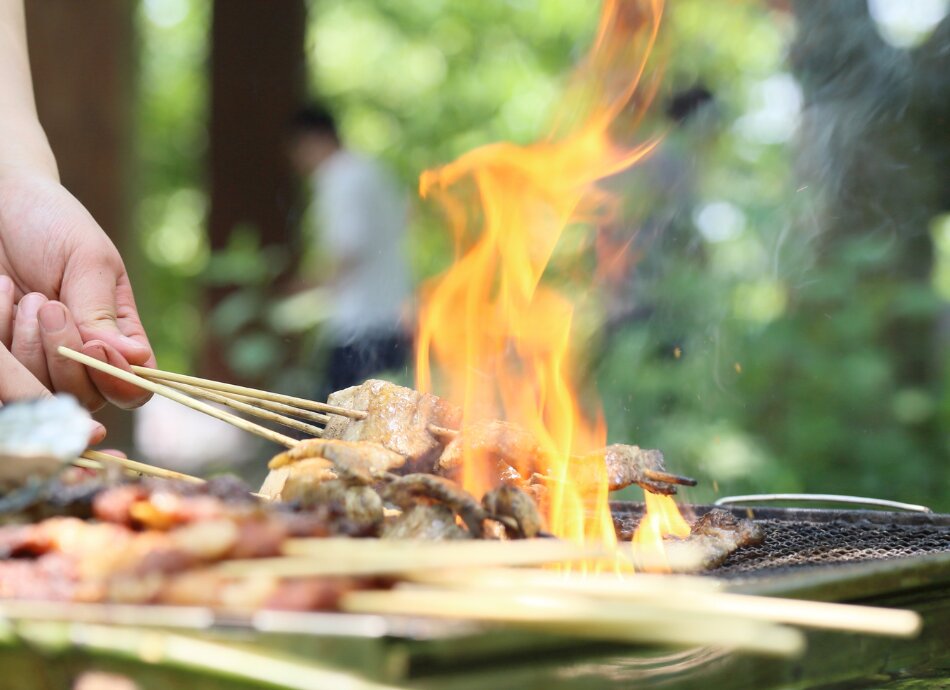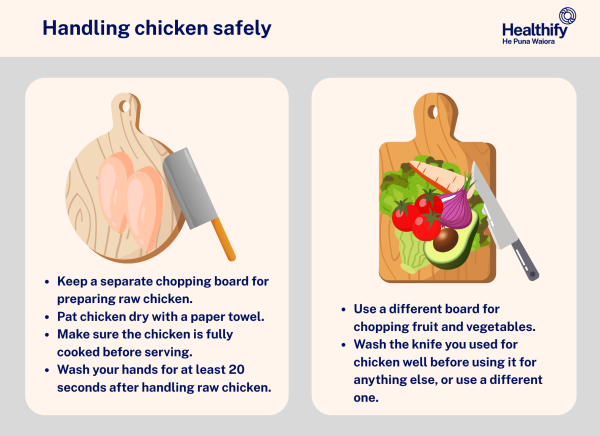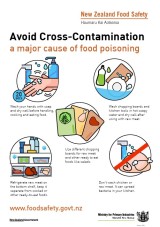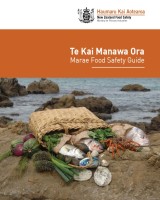Food safety – tips for summer
Key points about food safety in summer
- Sharing kai with friends and family is one of the great joys of the holiday season. But as we all head outdoors for holiday parties, picnics and barbecues, it’s important to be careful about food safety.
- Bacteria on food, such as Campylobacter, E-coli and Salmonella can multiply faster in warmer weather. Eating contaminated foods can make anyone sick.
- Pregnant women are at increased risk of food poisoning, so take extra care if you’re pregnant or preparing food for someone who is.
- You may be familiar with the four 'C' rules of food hygiene – clean, cook, cover and chill. On this page there are some simple tips to keep you and your whānau safe this summer.

1. Buy and eat food that is safe
Check the ‘use by’ date to make sure food is fresh when you buy it.
- If it's past its use-by date, say goodbye – eating this food could make you sick.
- A best-before date relates to the food's quality and if it looks and smells okay, it probably is. Check it, sniff it, taste it – don't waste it.
2. Gathered food
Always wash food that you or others have gathered, such as pūha or watercress. If you gather kai moana or seafood, check that the place you are collecting from is clean and free of pollution.
3. Keep hands and surfaces clean
Wash your hands before and after you handle raw foods. Make sure benchtops, cooking tools and barbecues are clean before you use them. When you prepare the meal, use separate utensils, plates and other tools to handle raw and cooked foods. After the meal, clean your benchtops and cooking tools well.
4. Rinse all fruits and veg
Rinse all of your fruit and vegetables under cold running water and then dry them with a clean cloth to help remove dirt and bacteria.
5. Handle chicken safely
Raw or undercooked chicken is the main offender for spreading serious illness from the bacteria Campylobacter. Chicken needs careful handling when it's raw. Avoid washing chicken in your kitchen sink as this can lead to contamination of your work surfaces, cloths and cooking utensils. If you want to remove raw chicken juices, pat the chicken dry with a paper towel and throw the paper towel straight into a waste bin. Keep a special chopping board for preparing chicken and don't use that board for chopping up fruit and vegetables. Don't use the same knife to cut up chicken and other foods until it's been well washed. Read more about handling chicken safely(external link) to keep yourself and your whānau safe.

Image credit: Healthify He Puna Waiora
6. Keep cold foods cold
Set your fridge temperature between 2°C and 4°C. Most harmful bacteria can't grow at low temperatures.
Keep cold dishes such as salads and puddings in the fridge until you’re ready to eat them. Store raw meats and seafood in the fridge until right before you cook them. Cover them and place them on the fridge’s bottom shelf so their juices can’t drip onto other food. Keep meat products away from ready-to-eat food such as fruit and vegetables. Other meat and seafood (kai moana) are sources of bacterial contamination, not just chicken.
If you’re eating outdoors, use an icepack or chilly bin to keep food cold.
7. Be food safe on the BBQ
Barbecuing and serving food outside in the warm summer months gives bacteria the ideal opportunity to multiply and cause food poisoning.
Make sure raw meat doesn’t touch cooked food or ready-to-eat foods (eg, salads). Keep raw and cooked meat separate on the grill. This is especially important for chicken meat.
Cook chicken, minced meat products and sausages right through until the juices run clear. Use a meat thermometer to check that your meat has been cooked to a safe temperature – at least 75°C in the thickest part of the meat. Don't assume that meat charred on the outside is cooked thoroughly on the inside.
8. Cover and refrigerate leftovers
Cover any dishes that are sitting out on the benchtop, barbecue or table to protect your food from flies, ants and other bugs. Don’t leave food out of the fridge for more than 2 hours. Instead, refrigerate or freeze leftover food after it's cooked, sealed in an airtight container.
If you think that food has been left out of the fridge for more than a couple of hours, it's better to throw it out than risk getting sick. If in doubt, don't eat it!
Reheat leftovers until they are steaming hot (over 75°C) stirring well so they heat all the way through.
9. Have a plan for your ham
You can take a vacuum-packed cooked ham straight from the fridge to the table. But if you like to glaze your ham and serve it hot, cook it at 160°C for 20 minutes per kilogram. You want the inside to reach at least 60°C – use a meat thermometer to check the temperature.
You can keep a cooked cured ham in the fridge for up to 2 weeks. Cover it with a clean damp tea towel and change the towel every day.
Eating cold ham of any kind when you are pregnant can come with the risk of a serious infection called listeria, which is harmful to the baby. Instead, cook or reheat ham until it’s piping hot (over 70°C) and eat it straight away.
10. Food safety in pregnancy
When you're pregnant (hapū) you have lower immunity which puts you at greater risk of food-related illnesses such as listeriosis and toxoplasmosis. These can be dangerous for you and your child. To be safe:
- wash and dry your hands carefully before handling food
- clean, cook and chill foods
- store leftover food in the fridge and don't eat them after 2 days
- avoid high-risk foods(external link).
Learn more about how to eat safely when you're pregnant.
11. Most importantly
If you've been unwell or have any symptoms of sickness, leave the food preparation and serving to others. Don't risk passing on your germs to your whānau.
Food safety at home(external link) Ministry for Primary Industries, NZ
Summer food safety(external link) Ministry for Primary Industries, NZ
Brochures
Food safety at home(external link) Ministry for Primary Industries, NZ, 2025
Pullout guide to food safety in pregnancy(external link) Ministry for Primary Industries, NZ, 2023
Te kai manawaora marae food safety guide(external link) Ministry for Primary Industries, NZ, 2018
Avoid cross-contamination – a major cause of food poisoning(external link) Ministry for Primary Industries, NZ, 2021
References
- Food safety at home(external link) Ministry for Primary Industries, NZ
- List of safe food in pregnancy(external link) Ministry for Primary Industries, 2021
- Eating well when pregnant(external link) Health New Zealand | Te Whatu Ora, NZ, 2024
- Christmas food safety(external link) Consumer NZ, 2020
- Top tips for food safety at Christmas(external link) Australian Institute of Food Safety, 2021
- Food safety(external link) Centers for Disease Control and Prevention, US, 2021
- Leftovers and food safety(external link) US Department of Agriculture Food Safety and Inspection Service, 2020
- Summer food safety(external link) Ministry for Primary Industries, NZ
Brochures

Avoid cross-contamination – a major cause of food poisoning
Ministry for Primary Industries, NZ, 2021
Credits: Healthify editorial team. Healthify is brought to you by Health Navigator Charitable Trust.
Reviewed by: Lily Henderson, Registered Dietitian
Last reviewed:







